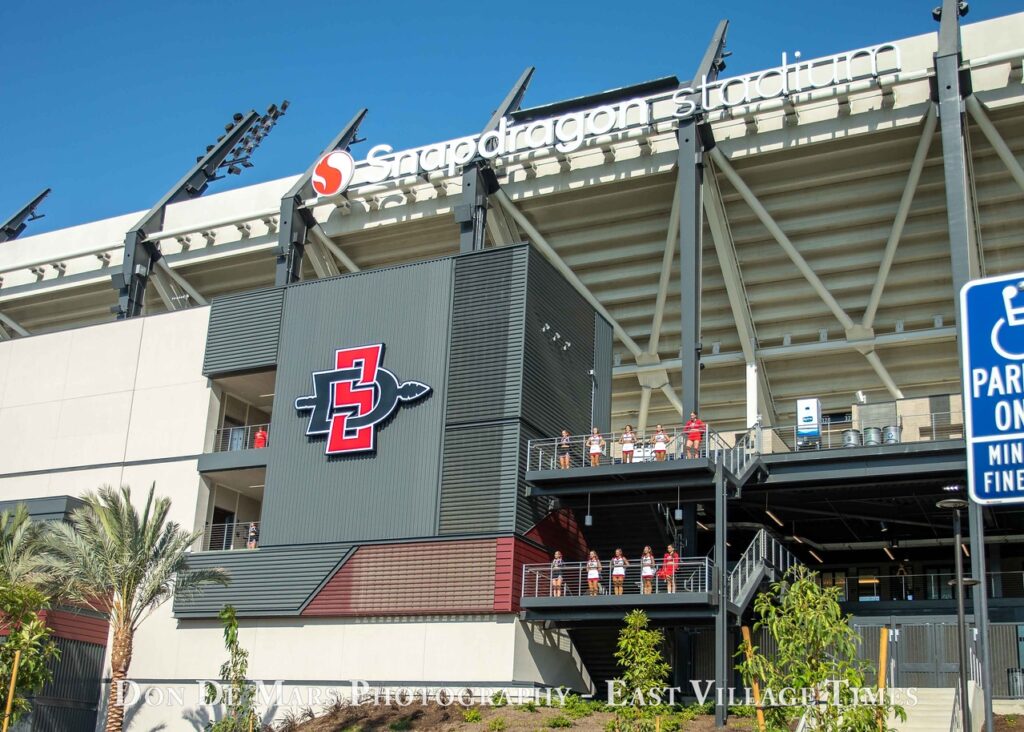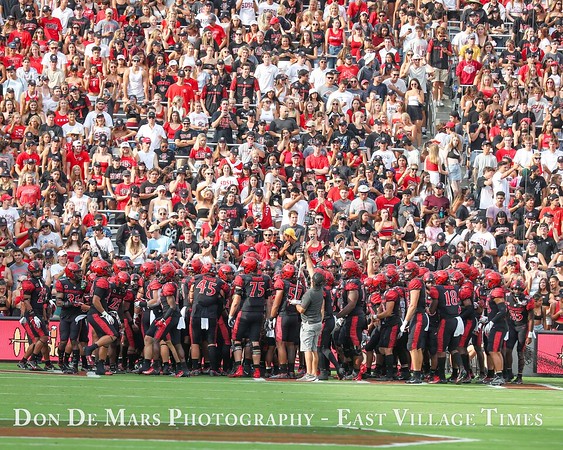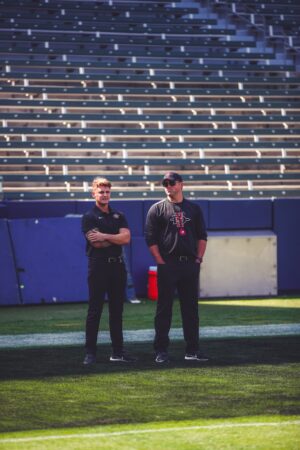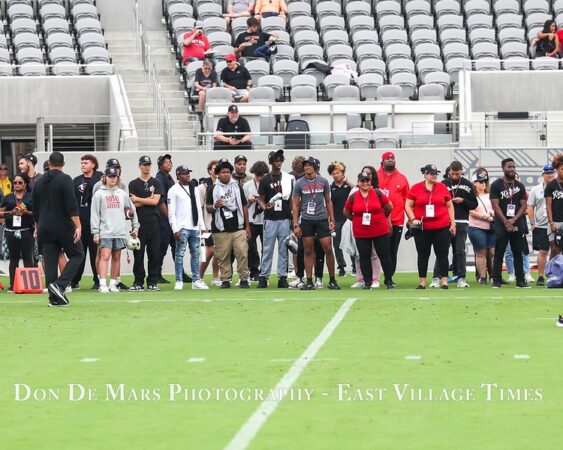Craig Smith is creatively leading SDSU’s recruiting efforts

SDSU Ribbon Cutting Ceremony. Credit: Don De Mars/EVT

Like all Group of Five (G5) schools, there are challenges to recruiting at San Diego State.
Rather than complain about the uneven playing field, SDSU’s coaches compete. Due to the program’s success, increasing resources, and the skill of the staff, the Aztecs have risen to a level where they consistently beat Power Five schools for the services of student-athletes.
Having established itself as one of the top G5’s in the country, the next five years has the potential to be the most important period in the program’s development. Across the country, the landscape of college athletics has changed with the NIL and one-time transfer rules. Locally, the opening of Snapdragon Stadium and the benefits conference realignment could bring to the school have given SDSU a once-in-a-generation opportunity.

At this critical juncture, head coach Brady Hoke chose Craig Smith to lead SDSU’s recruiting efforts as the Director of Player Personnel. His task is to navigate the whirlwind of change by maximizing the opportunities presented to the program while ensuring that its past success continues into the future.
“I was around his program all the time (growing up), and I knew two things about him,” Smith said on Episode 50 of The SDSU Football Podcast. “One, he was built on toughness and getting tough football players. And then, also, character is always going to come first because, in times of trouble or times of adversity, it’s always going to prevail. … He’s a great man, a great husband, a great father. … Obviously, we want good football players and high academic guys who earn their degrees, but first and foremost, my job is to evaluate are they a good character fit and (do they) fit this program’s mold.”
Smith is uniquely positioned to carry on the culture Hoke has established with the program. His father coached with Hoke for more than a decade, giving Smith a front-row seat of Hoke’s evolution from Ball State to SDSU to Michigan and back to the Mesa for a second time.
Name, Image, and Likeness
With all the potential positives surrounding the program, it is not guaranteed that the current movement in college football will be a net benefit for SDSU. The Aztecs can have a new stadium and a spot in the Power Five (P5), and their overall place in the pecking order of college football recruiting could be lower than it is now if Name, Image, and Likeness (NIL) opportunities do not materialize for its players.
Under the current paradigm, the primary divide is between G5 and P5 institutions. In the developing world of college athletics, programs will likely be separated by those with NIL collectives and those without.
The Dallas/Fort Worth (DFW) metropolitan has grown into an important recruiting area for SDSU. Southern Methodist University (SMU) is one of the local universities SDSU competes against for talent in the area. SMU can already offer players the opportunity to be Hometown Heroes and play in front of their friends and family. Mustang recruits are also offered $36,000 annually by the school’s NIL collective. Competing against $150,000 is a challenge even if the Aztecs are elevated to the P5, and SMU remains a G5.

Among the NIL opportunities for athletes at SDSU is Aztec Link. Founded by Aztec Hall of Famer JR Tolver, it is a collective in the same vein as the one at SMU. It is funded by fans and businesses. Started in the summer of 2022, recent fruits of Aztec Link’s endeavors has been a partnership with Sonic Drive-In. Fans interested in supporting SDSU’s athletes through Aztec Link can purchase a “subscription,” with the proceeds going directly to the players.
“Coach Hoke will be the first to say – that will be an offseason thing you’ll hear from our program a lot – (NIL) is something that we’ve always got to be improving in,” Smith said. “We are going to be pushing the collective a former player of ours has started. … (NIL)’s a game-changer. It gets brought up in every discussion I have now, whether they’re really interested in it or not, it at least gets brought up.”
One-Time Transfers
SDSU uses software called ARMS to organize its recruiting process. Among a host of features, the program allows the staff to create profiles for each potential player, build recruiting boards, and track contacts with recruits. If used well, ARMS improves communication among the staff because they are able to update notes on players in real time without having to wait for an in-person meeting. Smith’s job is to make sure ARMS is utilized properly to allow the program to continually document and improve its recruiting efforts.

As important as this work is, it is not the most foundational aspect of the process. At its core, recruiting is about numbers. Working with Hoke, Smith has to evaluate the number and age of players at a given position to determine the needs of the program over a five-year period.
There are many factors that make these calculations complicated. Players leaving early to the NFL, injuries derailing a career, or someone failing to develop changes the outlook of a position group. Athletes are also able to transfer one time without penalty. Add to all of this the extra year granted by Covid, and determining how many scholarships to give high school players with an eye on the long-term health of the program versus transfers from other colleges is daunting.
“The biggest thing is starting with your needs,” Smith said. “Obviously, you start there with any class. Seeing where things are falling. That’s a little challenging with the new day and age of the transfer portal a little bit and also with the Covid years. That always plays a factor. With our program specifically, we hold those conversations (with potential Super Seniors) postseason. The discussion of position needs and numbers is always forever changing. Talk about Jalen Mayden, for example, started out (the season) at the safety position and that type of number, and now he’s at quarterback and coming back.”
Conference Realignment
As if Smith’s job was not challenging enough, SDSU sits in no man’s land when it comes to conference realignment. While they are certainly favored to be elevated into a higher conference, they are currently in the Mountain West (MW). It is possible, if unlikely that they remain there for the foreseeable future. Whatever complaints there are about the MW, SDSU Mission Valley, Snapdragon Stadium, multiple top 25 national rankings, and all of the success over the last 20 years on the Mesa happened as a member of the conference.
Conversing about the future without disparaging the present is a delicate balance. Smith admitted to talking about all of the chatter surrounding the program with the players SDSU is courting. Following Dan Patrick’s report last week that SDSU would move to PAC-12, high-level recruits, who were only somewhat considering the program before, reached out to express their increased interest. Smith and the staff are careful to only use factual information to answer the legitimate questions players and their families have about where the Aztecs will be playing in the future.
Source: San Diego State is expected to join the Pac 12. Announcement could be made as early as this week. #SDSU #Aztecs pic.twitter.com/o1n6YkTLKN
— Dan Patrick Show (@dpshow) November 7, 2022
“All recruits are doing their homework and fact-checking because everybody is obviously selling their own program,” Smith explained. “The nice part with conference realignment is if they go on the internet and search us, there’s a lot of people talking about us in that conversation. So, it’s not just something we’re making up internally, trying to sell to a recruit. This is real talk. Obviously, there are major, major networks putting it out there that we are in those discussions. Our athletic director has come out and made statements that we are in conversations. These are things that we reference.”

Snapdragon Stadium
There is no question Snapdragon Stadium is a huge opportunity for the program. It is a beautiful, world-class building. Promises of incredible sight lines, tremendous food and beverage options, and technological innovations have all been kept even amongst the operational issues that come with the opening of any venue. While it is easy to assume SDSU’s new home will deliver recruiting wins for the program, Smith is actually tasked with getting that done.
Interest from recruits has been so robust that Smith has had to change the way the program hands out invitations to attend games. When the team played in Carson the past two seasons and in SDCCU stadium before that, SDSU had an open system where anyone who wanted to come was admitted. Space is more limited at Snapdragon. For recruits, Aztec games are now invitation-only events.
How to best utilize the new stadium is not message board fodder for Smith. He has to make decisions on how and when to use it. On official visits during the season, he hosts lunches with recruits and their families on game days on the Sycuan Piers. Perched with an exquisite view of Mission Valley, Smith and the recruiting staff break bread with these VIPs hoping to find future Aztecs.
“(Snapdragon) definitely has created excitement,” Smith said. “When recruits come, obviously, it’s a huge selling point. We’ve had multiple, multiple recruits that have visited all the different Power Fives and are, obviously, blown away by Snapdragon. It’s always hard choosing if we are going to start with it or end with it on visits. That’s always a debate, do you want to end with a bang or start with a bang.”
Five years from now, the staff will have a clearer picture of how to maximize Snapdragon’s impact in the recruiting process. Building off the decisions Smith makes now, they will be able to fine-tune their approach. It is a luxury SDSU’s Director of Player Personnel does not have, and the decisions he makes today will impact who is starring for the Aztecs down the road.
[wpedon id=”49075″ align=”right”]
Replacing Matt Razzano
One of the first changes Hoke made when he was hired a second time as head coach was to invest in the recruiting department. At the time, Matt Razzano was the only staff member solely dedicated to evaluating and bringing players to SDSU. Hoke added three members to the team. He has gone on record saying that adding more would be a priority when the increased budgets from Snapdragon Stadium materialized. Armed with more help, Razzano revamped the recruiting process at SDSU. Earlier this year, Razzano stepped down, and Hoke tapped Smith to replace him.
“A lot, to be honest with you,” Smith replied when asked what he wanted to keep that Razzano began. “I’ll be the first to admit I had a lot of learning to do in this job. I was not recruiting prior. … Matt obviously did a lot of great things. His classes speak for themselves, the people that he helped bring into the program. His biggest thing, honestly, was he had a great system when it comes to the processes and letting those play out.”
Razzano is still in San Diego and continues to be a resource for Smith. The wealth of experience SDSU’s staff possesses is something Smith said he also leans on as he turns all of these challenges into opportunities.
There are many reasons why Craig Smith is the perfect person, at the perfect time, to lead SDSU’s recruiting in the present moment. Chief among them is his creativity. In the face of all that is transpiring at SDSU, they need someone who will take risks to find out-of-the-box solutions and will be undeterred when those ideas do not work out. Smith’s creative mind allows him to adjust to the uncertainty surrounding the sport without losing momentum toward capitalizing on the once-in-a-lifetime chance to raise SDSU to heights never seen before.
My earliest sport’s memory involve tailgating at the Murph, running down the circular exit ramps, and seeing the Padres, Chargers and Aztecs play. As a second generation Aztec, I am passionate about all things SDSU. Other interests include raising my four children, being a great husband and teaching high school.